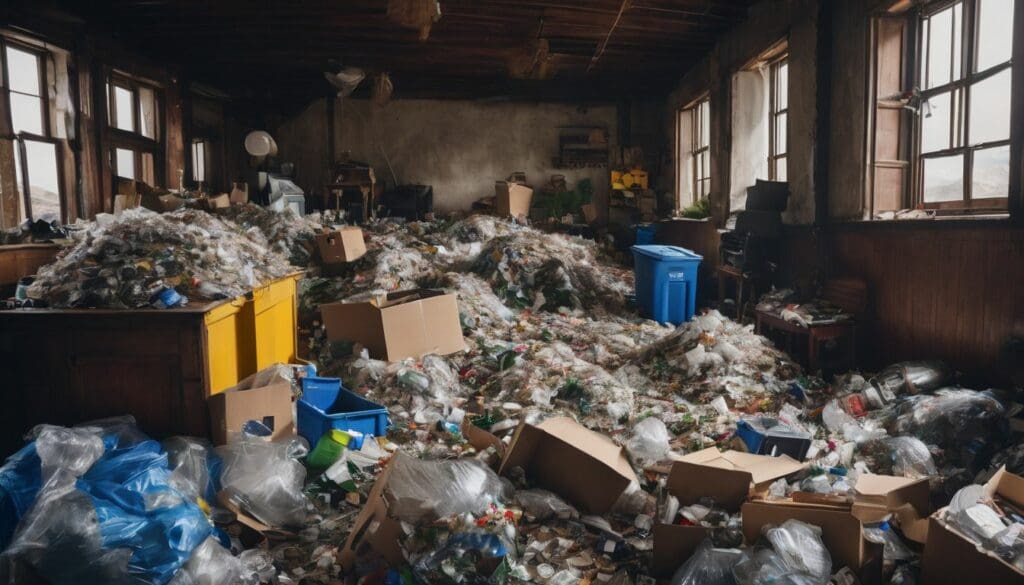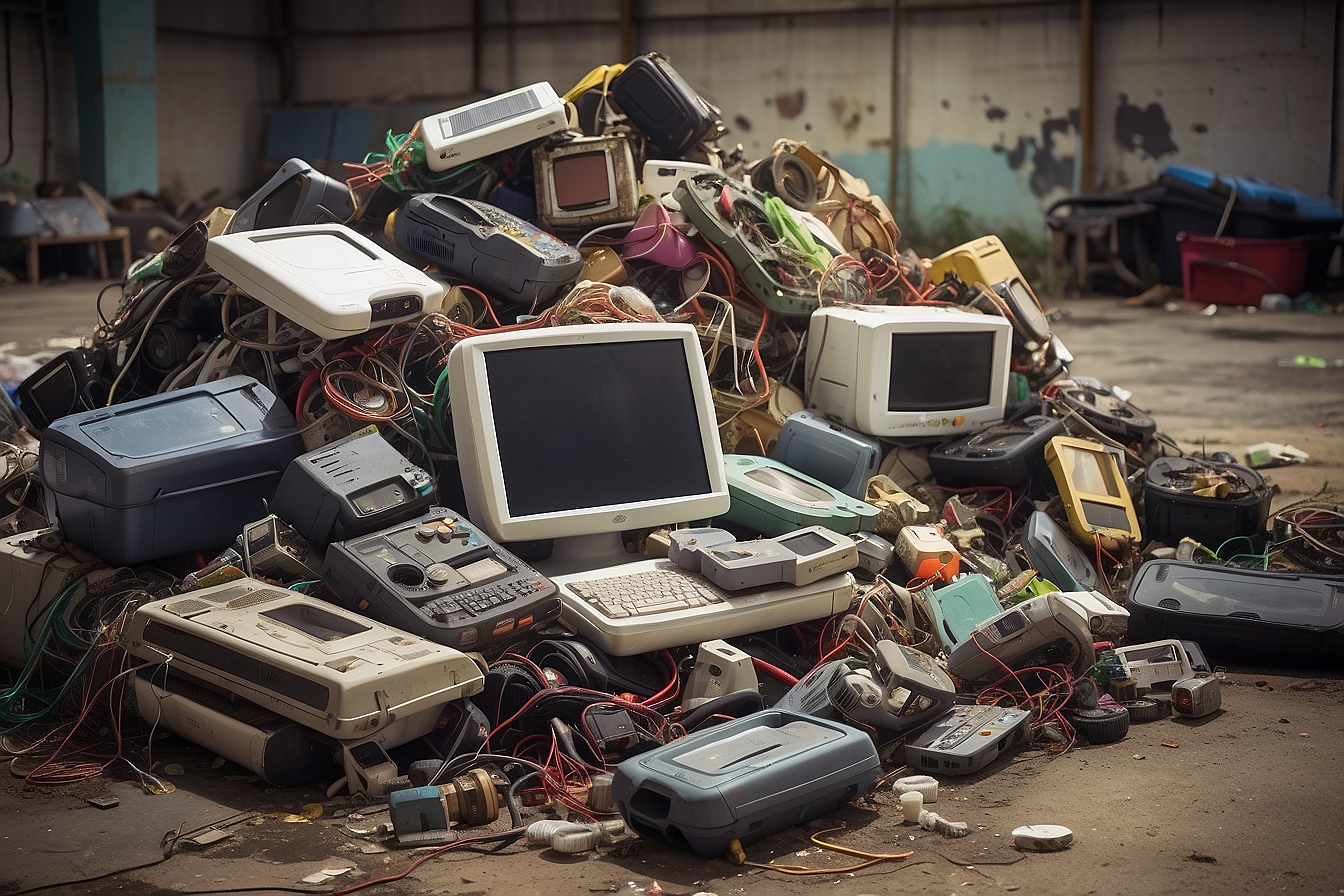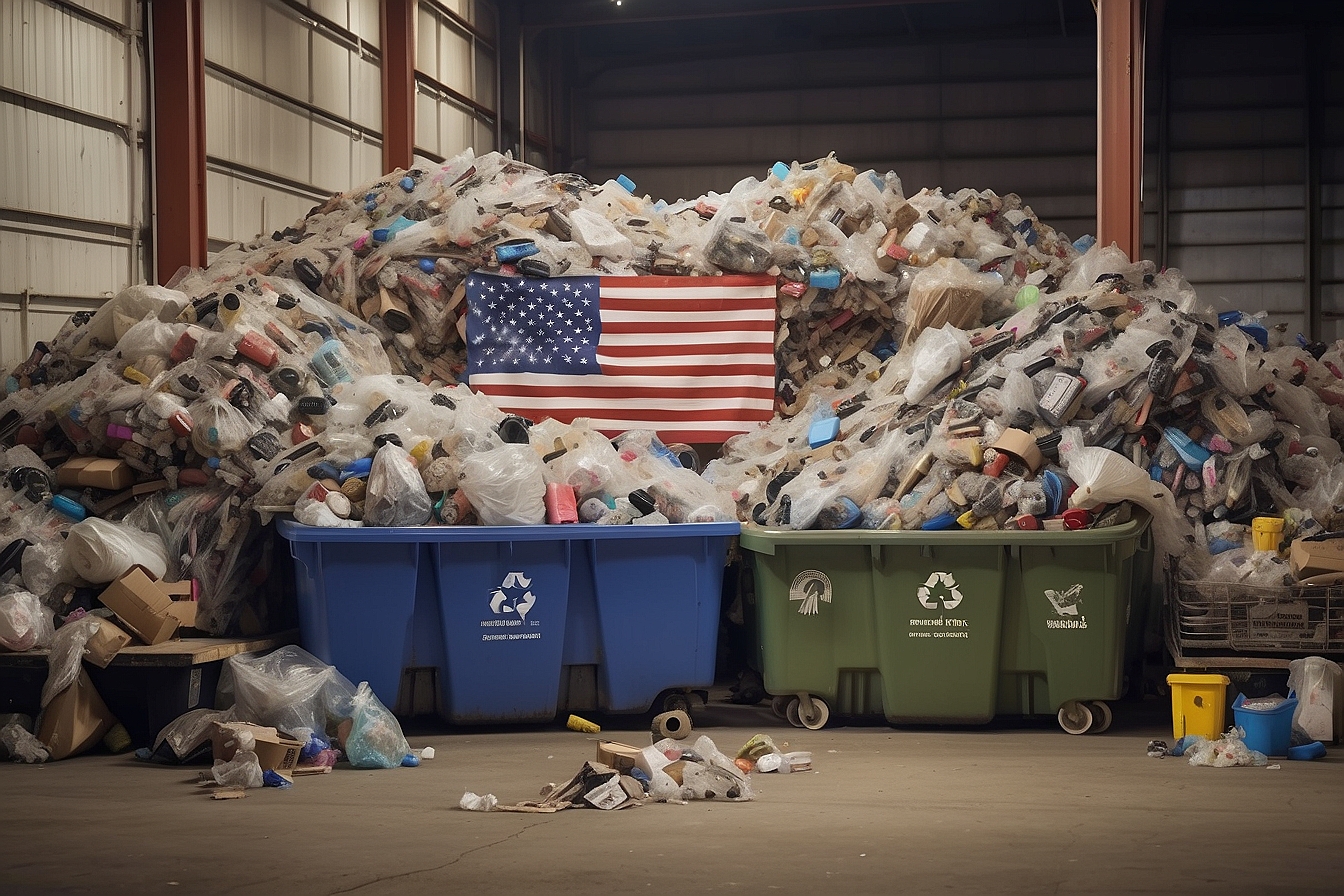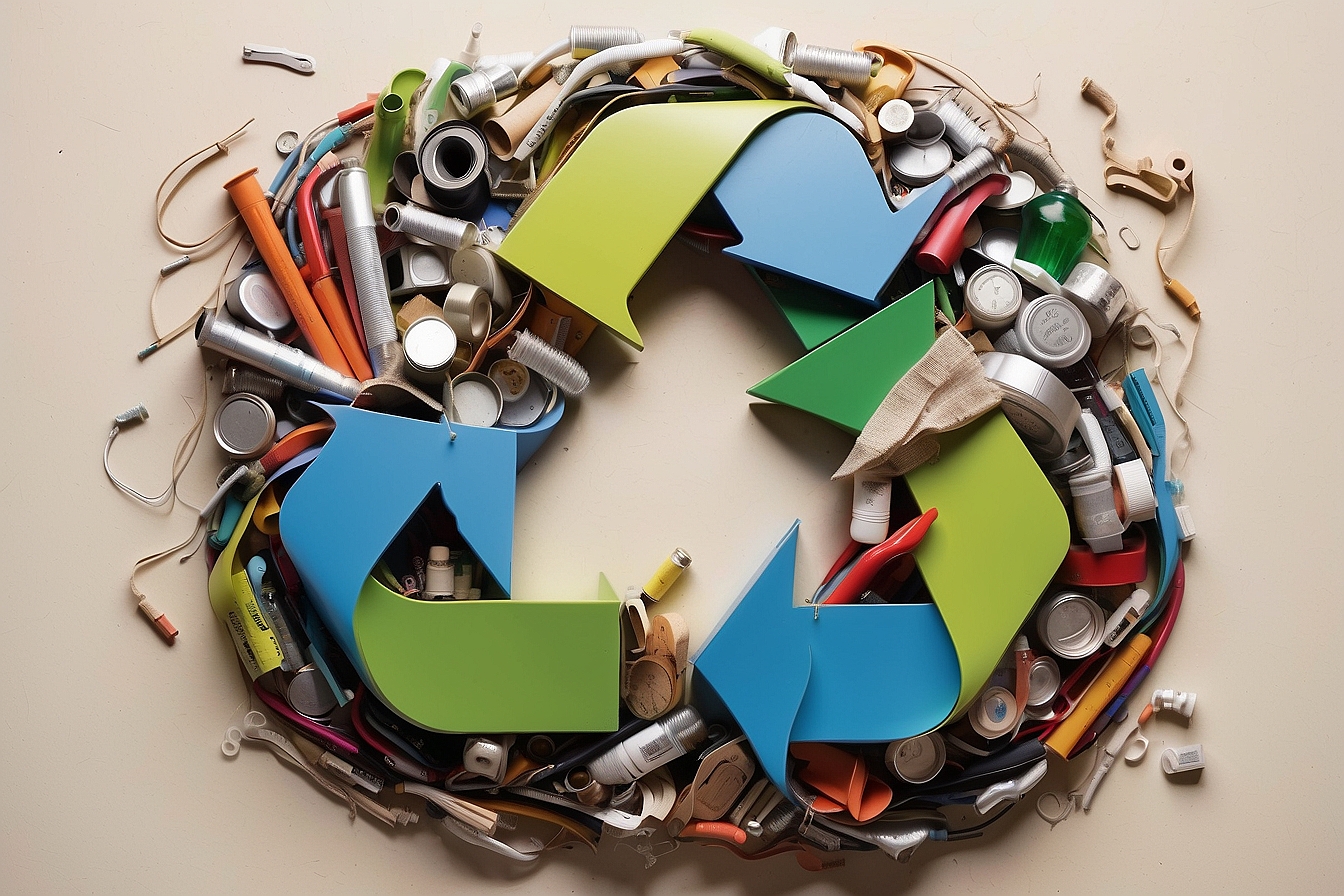We’ve all stood there, haven’t we? Hovering over the recycling bin with a furrowed brow, clutching some questionable item and wondering where on earth it should go. It seems we’re in good company; even the most conscientious among us have been caught up in the somewhat baffling rules of recycling.
Fear not – we’re about to shed light on those pervasive myths that might be undermining your eco-efforts, especially against an unsettling backdrop where a whopping 91% of plastic reportedly isn’t making it through the recycling process (a startling fact from research back in 2017).
Get ready for some enlightening eco-truths that promise to spruce up your recycling know-how. Myth-busting has never been so necessary!
Key Takeaways
- Recycling saves significant energy, contrary to some beliefs. For instance, making new aluminium from recycled material uses 95% less energy than producing it from raw ore, and recycling one tonne of paper can conserve around 7,000 gallons of water.
- Not everything with a recycling symbol is recyclable everywhere. The symbol indicates the type of plastic but doesn’t guarantee local facilities can process it. It’s crucial to check your area’s recycling guidelines for what can be accepted.
- Compostable plastics are not suitable for traditional recycling systems. They require industrial composting facilities and should not be mixed with regular plastics as they contaminate the recycling stream.
- Reducing and reusing are often more effective than recycling in waste management hierarchy. While recycling plays an essential role in resource conservation, minimising initial consumption is also key to sustainable living.
- Contamination significantly affects the efficiency of recycling because even small amounts can spoil large batches of materials, leading to increased costs and potential landfill disposal instead of being turned into new products.
Common Recycling Myths
Many people believe that recycling doesn’t actually save energy and that everything will eventually decompose over time. Another common misconception is that “natural” and “eco-friendly” products are always environmentally friendly, and that compostable plastics can be recycled.
Recycling doesn’t save energy
Let’s tackle a common myth: recycling doesn’t save energy. Actually, we save loads of energy every time we recycle materials instead of producing them from scratch. For example, recycling aluminium saves up to 95% of the energy needed to make new aluminium from raw bauxite ore.
That’s massive savings on the energy front!
Not only metals; paper and plastics also tell a similar story. By recycling just one tonne of paper, we can conserve around 7,000 gallons of water and enough electricity to power an average home for six months! And with plastics, it takes far less energy to reshaping recycled plastic than producing new plastic from oil or gas.
So yes, through smart waste management and efficient resource use in our manufacturing processes, we’re significantly cutting down on greenhouse emissions – all thanks to recycling doing its part in conserving precious renewable resources.
Everything decomposes over time
When waste is dumped in a landfill, it undergoes decomposition over time. This process releases harmful greenhouse gases like methane, which are potent contributors to global warming.
While some items may take decades or even centuries to break down completely, others—like plastic—can decompose into smaller particles that pollute soil and waterways, harming wildlife and ecosystems.
Organic matter breaks down through natural processes but can lead to the generation of leachate—a toxic cocktail that seeps into the ground beneath landfills. Therefore, landfill decomposition poses significant environmental hazards and emphasises the importance of reducing waste production and actively promoting recycling as part of sustainable living efforts.
“Natural” and “eco-friendly” products are always environmentally friendly
Many people believe that “natural” and “eco-friendly” products are always good for the environment. However, it’s important to remember that just because a product is labelled as such does not automatically mean it’s environmentally friendly.
Some natural products may still require significant resources or energy to produce, while some eco-friendly products could have negative impacts during their disposal or at the end of their life cycle.
It’s crucial to consider the entire lifecycle of a product and look beyond its initial label to truly assess its environmental impact.
Understanding the true implications of “natural” and “eco-friendly” labels helps us make more informed choices as consumers. We need to scrutinise these claims, looking deeper into how these products are sourced, produced, used, and disposed of.
This approach empowers us to make choices that align with our commitment to environmental sustainability and support a circular economy where materials can be reused or recycled efficiently.
The recyclable symbol guarantees a product is recyclable
The recyclable symbol does not always ensure that a product is recyclable. It simply indicates the type of resin used in making the plastic item, rather than its ability to be recycled.
To determine if a product is recyclable, it’s crucial to check with local recycling facilities or guidelines provided by your municipality.
Consumers should also look for specific instructions on how to properly recycle each item. Some products may require certain preparation such as removing labels or separating materials before being placed in recycling bins.
Compostable plastics can be recycled
Compostable plastics cannot be recycled in the same way as traditional plastics. When compostable plastics are mixed with regular recyclables, they can contaminate the recycling stream and reduce the quality of other recyclable materials.
Compostable plastics should be processed at industrial composting facilities to break down into organic matter, which can then be used for soil enrichment.
Switching to biodegradable or compostable plastics alone does not solve the plastic pollution problem. We should focus on reducing plastic use overall and opt for reusable alternatives.
Making informed choices about packaging materials is crucial for a sustainable future.
Recycling doesn’t make economic sense
Despite the common belief, recycling is not always a profitable venture. The costs involved in collection, sorting, and processing of recyclable materials often exceed the revenue generated from selling the recycled products.
This economic disparity can be attributed to various factors such as low market demand for certain recycled materials and fluctuating commodity prices. It’s essential to recognise that while recycling carries considerable environmental benefits, it may not always make economic sense.
Furthermore, there are expenses associated with contamination in the recycling stream which require additional resources for proper disposal. As environmentally conscious individuals interested in supporting conservation and reducing waste generation, it’s important to acknowledge these economic challenges within the recycling industry while also seeking ways to promote sustainable practices despite this barrier.
Only cans and bottles can be recycled
Despite the common belief that only cans and bottles can be recycled, it’s crucial to understand that many other items can also be recycled. Materials such as paper, cardboard, glass, and certain types of plastic are all recyclable.
It’s important to check with local recycling facilities to determine what materials they accept and how they should be sorted for recycling. By expanding our understanding of recyclable materials beyond just cans and bottles, we can make a significant impact on reducing waste and conserving resources.
In addition to cans and bottles, other recyclable items include newspapers, magazines, aluminium foil (clean), steel food containers (washed), milk cartons (rinsed), household cleaning product containers (rinsed), food jars (clean), wine or beer bottles (rinsed), cereal boxes (flatten).
Recycling ends up in the landfill
Many people believe that recycling ends up in the landfill, but this is a common misconception. While it’s true that not all items make it to the recycling plant due to contamination or improper sorting, recycling does help divert a significant amount of waste from ending up in landfills.
However, it’s essential to ensure that recyclables are sorted correctly and free from contaminants like food residue or non-recyclable materials. By doing so, we can contribute to reducing the amount of waste sent to landfills while conserving resources and protecting the environment.
Recycling plays a crucial role in preventing valuable materials from being buried in landfills, contributing to source reduction and promoting sustainable practices. Properly recycled items can be turned into new products, reducing the need for raw materials and energy consumption associated with manufacturing processes.
Debunking Recycling Myths
Caps and lids do not need to be removed before recycling, and the recycling symbol does not determine a product’s recyclability. Also, while recycling is important, it’s not always the best way to reduce waste.
Caps and lids do not need to be removed
When recycling, it’s important to understand that caps and lids do not need to be removed. This helps streamline the recycling process and reduces unnecessary waste at recycling facilities.
- Recycling technology has advanced, allowing for the processing of caps and lids along with the rest of the recyclables.
- Crushing and sorting machinery at modern recycling facilities are designed to effectively handle caps and lids, so there’s no need to remove them.
- Leaving caps on bottles and containers can prevent small items from falling through sorting equipment, ensuring more efficient processing.
- When caps and lids are left on, they get recycled alongside their respective containers, contributing to a more sustainable recycling process.
- By keeping caps and lids on, we can help conserve energy and resources in the recycling process without adding additional unnecessary steps.
The recycling symbol does not determine recyclability
When it comes to recycling, the presence of the recycling symbol on a product does not always guarantee that it can be recycled. While the symbol indicates that an item is made from recyclable materials, it doesn’t necessarily mean that your local recycling facility will accept it.
Therefore, it’s important to check with your local waste management authorities or recycling program to know which items they can actually process and recycle.
Furthermore, some products with the recycling symbol may not be economically viable or environmentally friendly to recycle due to their composition or market demand for the recycled materials.
Recycling is not the best way to reduce waste
Contrary to common belief, recycling is not the ultimate solution for waste reduction. While it plays a crucial role in mitigating environmental impact, other practices such as reducing and reusing are equally essential.
By minimising consumption and finding ways to prolong the lifespan of products, we can significantly decrease the amount of waste generated. Shifting our focus from solely relying on recycling to incorporating a holistic approach that includes waste reduction at the source is imperative for sustainable environmental stewardship.
Embracing a mindset that prioritises waste prevention through reduced consumption and reuse can be more impactful in curbing environmental strain than merely relying on recycling. By emphasising these practices alongside responsible recycling efforts, individuals can collectively contribute towards creating a greener and more sustainable future.
Materials can be recycled multiple times
Materials can undergo recycling processes repeatedly. This reduces the need for raw materials and minimises environmental impact. Recycling conserves resources and energy while promoting a sustainable lifestyle.
It also supports the reduction of waste in landfills, benefiting the environment and future generations.
Recycling various materials multiple times empowers eco-friendly practices and contributes to green living initiatives. By choosing products made from recyclable materials, we actively support energy conservation and environmentalism, ensuring a better world for all.
Recycling actually saves more energy
Recycling saves more energy than producing items from raw materials. When we recycle, we use less energy in extracting, transporting, and processing natural resources. This reduces our reliance on fossil fuels and decreases greenhouse gas emissions that contribute to climate change.
By choosing to recycle materials like paper, glass, and aluminum, we conserve energy and protect the environment for future generations.
When products are recycled instead of being made from scratch using raw materials, it significantly reduces the amount of energy required in the manufacturing process. Recycling helps us to save valuable resources while decreasing the demand for new production methods that consume large amounts of energy.
Even a little contamination in recycling can have a significant impact
Contaminants like food residue, liquids, and non-recyclable materials can spoil a whole batch of recycling. These contaminants make it difficult to process the recyclables into new products, increasing costs and reducing the quality of recycled goods.
As a result, contaminated recycling loads may end up being sent to the landfill instead of being repurposed.
Individuals should be mindful of what they put in their recycling bins to prevent contamination. Rinsing out containers before recycling, removing labels from jars and bottles, and familiarising oneself with local recycling guidelines can help minimise contamination and ensure that more materials are effectively recycled.
Recycling does not pay for itself
Even a little contamination in recycling can have a significant impact. However, it’s crucial to understand that recycling does not pay for itself. While it’s an essential practice for environmental sustainability, the economic reality is that the costs of collecting, processing, and transporting recyclable materials often exceed the revenue generated from selling them.
As environmentally conscious individuals, supporting conservation and eco-friendly practices is vital even if it doesn’t always result in direct financial gain.
To uphold our commitment to protecting the environment, we must continue to recycle despite its economic challenges. By doing so, we contribute to conserving natural resources and reducing our carbon footprint – outcomes that are invaluable when considering the long-term health of our planet.
Conclusion
In conclusion, it’s vital to debunk misconceptions about recycling. We must understand that not all items can be recycled, and the symbol doesn’t necessarily mean an item is recyclable.
Comprehending these myths allows us to make more informed decisions as environmentally conscious individuals. We play a crucial role in conserving our planet by educating ourselves and others about sustainable practices.
It’s time to dispel these myths and take meaningful actions towards a greener future.
FAQs
1. What does the recycling symbol on packaging mean?
The recycling symbol indicates that the packaging can be recycled, promoting eco-friendly practices.
2. Can everything with a recycling symbol be recycled everywhere?
No, not all items with recycling symbols are accepted in every local recycling programme; it’s important to check your local guidelines.
3. Is it true that some recyclable materials are not actually recycled?
Yes, even if an item is marked as recyclable and placed in the correct bin, it may not be recycled due to various factors like contamination or market demand.
4. Does debunking recycling myths help improve ecofriendly practices?
Absolutely, understanding the truths behind these myths empowers us to follow more effective ecofriendly practices when sorting and disposing of our waste.





